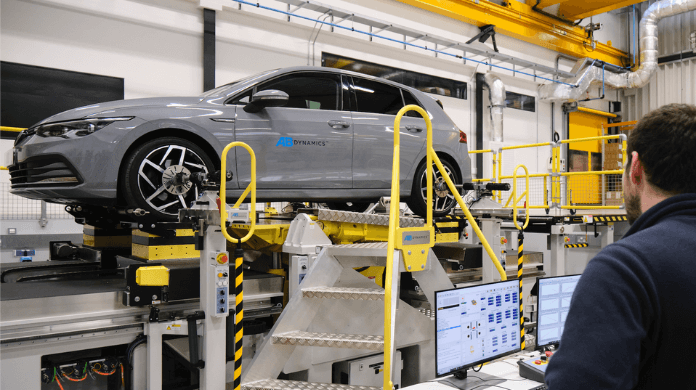Updated on 20.10.2024 after Euro NCAP launched their New Truck Safety Ratings
The impact of Advanced Driver Assistance Systems (ADAS) on truck safety has taken a significant leap forward with the launch of Euro NCAP's Safer Trucks Rating. As the world becomes increasingly reliant on commercial vehicles for goods transportation, truck safety has become a critical focus. In this article, Andrew Pick, Business Director of Track Test Systems at AB Dynamics, explores the impact of ADAS on truck safety and how Euro NCAP's new rating system will help to transform the safety of the heavy vehicle sector.

Why is Euro NCAP focussing on truck safety?
Euro NCAP (European New Car Assessment Programme) has recognised the urgent need to address truck safety due to the disproportionate impact of heavy vehicles on road fatalities. Despite representing only 1.5% of vehicles on Europe's roads, heavy trucks are involved in almost 15% of road fatalities. To address this critical issue, Euro NCAP has introduced a new rating system for trucks, similar to its successful car rating scheme, which aims to encourage the adoption of safer trucks and provide valuable safety information to consumers and fleet operators.
What are the new Euro NCAP heavy vehicle tests?
The new Safer Trucks Rating covers four key areas: safe driving, crash avoidance, crash protection and post-crash safety. Safe driving covers aspects such as driver vision, engagement and monitoring. The crash avoidance category covers autonomous emergency braking and lane departure warning, and systems that can protect vulnerable road users like blind spot detection. The crash protection category enhances occupant protection but importantly also considers crash compatibility. As most casualties from accidents with trucks are outside the vehicle, ensuring crash compatibility with cars and pedestrians has the potential to offer real safety benefits. While post-crash safety covers rescue information and extrication.
How do ADAS systems improve truck safety?
ADAS systems can improve truck safety in several ways:
- Collision Mitigation: ADAS systems can use radar and camera technology to detect potential collisions and warn the driver, or even take control of the vehicle to avoid a collision.
- Blind Spot Detection: Blind spot detection systems use sensors to detect when a vehicle or cyclist is in the truck's blind spot and warn the driver.
- Lane Departure Warning: Lane departure warning systems use cameras to detect when the truck is drifting out of its lane and warn the driver.
- Automatic Emergency Braking: Automatic emergency braking systems use radar and cameras to detect potential collisions and automatically apply the brakes if the driver does not respond in time.
What are the benefits of using ADAS systems in trucks?
A key benefit to using ADAS systems in trucks is improved safety; both for the drivers of the trucks, but just as importantly for other road users. ADAS systems can help prevent accidents by detecting potential collisions and warning drivers or taking control of the vehicle to avoid a collision.
One of the first examples of ADAS systems in trucks was the mandatory fitment of Advanced Emergency Braking Systems (AEBS) – which was introduced into all new types of N2 and N3 category vehicles through UN ECE Regulation 131 in 2013. These systems prevent (or lessen) accidents between trucks and other road users by drastically reducing the speed of the truck when a stationary or slow-moving vehicle is detected in its path.
What does Euro NCAP’s new Safer Trucks Rating mean for future ADAS testing programmes?
The new Euro NCAP Safer Trucks Rating is a positive step towards safer heavy trucks and ultimately safer roads. As with all NCAP programmes, the drive to continually improve safety will apply to this new heavy vehicle rating too. As a result, we expect to see future protocols becoming more challenging and extensive, with a greater focus on assessing the effectiveness of these systems in real-world scenarios that would otherwise result in the most serious accidents. Manufacturers will also be under pressure to develop and refine their ADAS systems to meet the higher standards set by Euro NCAP.
Euro NCAP has had a significant impact on the car industry by promoting and improving vehicle safety standards. Consequently, ADAS testing technologies have become more sophisticated, realistic, and robust. Truck manufacturers and operators alike, can now benefit from these proven ADAS testing technologies, especially those that have been developed with system robustness in mind. At AB Dynamics, we have been at the forefront of developing ADAS testing technologies and have a range of driverless robots, VRU targets and platforms that are already heavy vehicle ready. As a result, truck manufacturers can now access tried and tested ADAS testing solutions, which can help improve the safety of their vehicles and ensure they comply with new test and regulatory standards.
Key takeaways
- Euro NCAP's new Safer Trucks Rating scheme aims to drive innovation in truck ADAS technologies and promoting the adoption of advanced safety features across the industry.
- The comprehensive rating system, covering safe driving, crash avoidance, crash protection, and post-crash safety, sets a new benchmark for truck safety.
- AB Dynamics played a pivotal role in working alongside other industry partners to develop and demonstrate the new test protocols, showcasing our expertise in ADAS testing for heavy vehicles.
- The successful implementation of these protocols proves that rigorous safety testing is achievable for trucks, paving the way for significant improvements in road safety.
To discuss how AB Dynamics can support your ADAS testing requirements, contact us at info@abdynamics.com or click here to learn more about our solutions for heavy vehicle testing.











